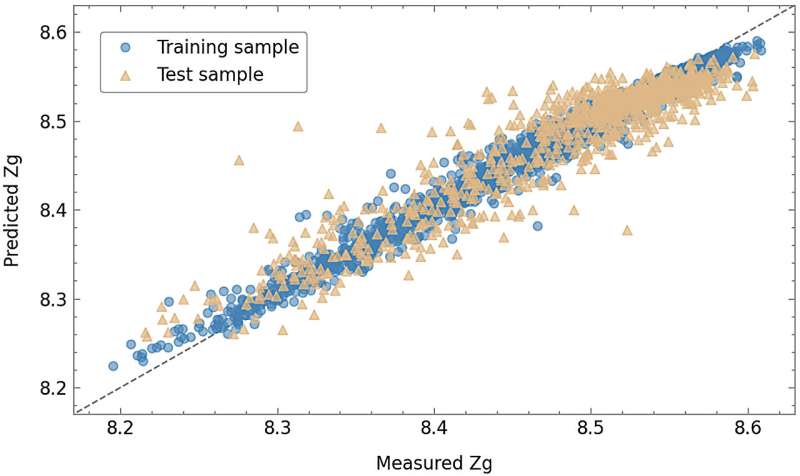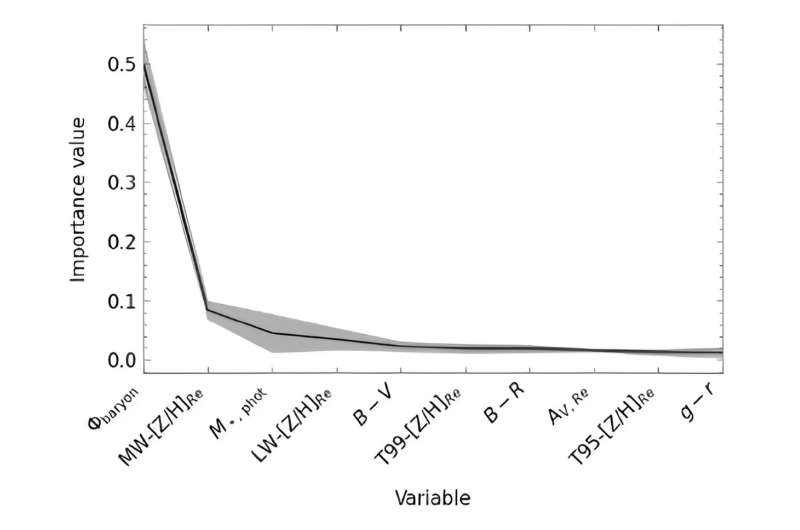February 7, 2024 feature
This article has been reviewed according to Science X's editorial process and policies. Editors have highlighted the following attributes while ensuring the content's credibility:
fact-checked
peer-reviewed publication
trusted source
proofread
Finding the best predictor for a galaxy's metallic content

A team of astronomers has found that the total mass of stars in a galaxy is not a good predictor of the galaxy's abundance of heavier elements, a surprising result according to previous studies. Instead, the gravitational potential of a galaxy is a much better predictor. The findings are published in the journal Astronomy & Astrophysics.
This is important because when investigating and classifying galaxies, "scaling relations" play an important role in understanding galaxy formations and evolutions. They are significant relationships that help predict other properties of a star, nebula and galaxy if certain simpler properties are known, for example, trends between properties like mass, size, luminosity and colors.
When studying galaxies, one oft-reported relation is with the "metallicity" of the galaxy. As the vast majority of ordinary (non-dark) mass of the universe—about 98%—is hydrogen or helium, astronomers call the rest "metals," and call their abundance "metallicity." Metals were produced long (relatively) after the Big Bang, so the degree of metallicity of an object is an indication of stellar activity after the Big Bang.
Metallicity is defined as the mass fraction of the metals divided by the mass of the star, nebula or galaxy. (In practice astronomers have a few ways of calculating metallicity, but all indicate the degree of heavier elements.) In practice, often only oxygen or iron are used as proxies for the metallicity. Oxygen is the most abundant heavy element in the universe, and iron is also common as it has the most stable nucleus.
In the present study, led by Laura Sánchez-Menguiano of the University of Grenada in Spain, the group used data on more than 3,000 nearby star-forming galaxies from the Mapping Nearby Galaxies survey done at Apache Point Observatory in New Mexico in the United States.

Using 148 parameters that describe some aspect of each galaxy in this set, the group used a computer algorithm called the "random forest regressor algorithm" to establish scaling relations between the many galactic parameters, for this entire group of galaxies, to find the one that best predicts the gas-phase metallicity of the galaxy, which is the metallicity of the gases in the galaxy's interstellar medium.
For the gas-phase metallicity they used as a proxy the ratio of the oxygen abundance—a chemical that traces the evolution of galaxies—to hydrogen mass, measured at a distance of one effective radius of the galaxy.
The amount of metals in galaxies gradually increases, as stars continually form in a galaxy, and as stars go supernova, spewing all their elemental mass into the galactic interstellar medium. The galaxies' internal processes, as well as other, external processes, leave an imprint on the gas-phase metallicity, which astronomers have found is a very powerful tool to understand the characteristics and development of galaxies.
The random forest algorithm is a supervised machine learning technique that astronomers have used extensively in the astronomical community with great success. The technique used a combination of decision trees that finds the input features that contain the most information on an output, or target feature. Here the input features were the many galactic properties, and the target feature was the gas-phase metallicity.
Ultimately the algorithm, through the many combinations of decision trees, creates a model to predict the target feature using a set of conditions on the values of the many input features.
The regression showed that the best predictor of the gas-phase metallicity was the baryonic gravitational potential of the galaxy, the ratio of stellar mass to the effective radius. (The gravitational constant G is not included, because it's a constant that just gets in the way and could always be added in later if desired.)
Baryons are particles, like the proton or neutron, which are made of three constituents—quarks. These particles interact via the strong force, so the electron is not a baryon. (In any case, the mass of a proton and neutron is almost 2,000 times greater than an electron, so electrons contribute very little to stellar and interstellar mass.)
The baryonic gravitational potential of a galaxy gives a better prediction of the gas-phase metallicity than the galactic stellar mass. In fact, analysis showed that the strongest dependent was the ratio (total stellar mass over effective radius) to the 0.6 power. The result was good for galactic masses between 300 million and 300 billion times the mass of the sun. The group argues that the power 0.6, less than one, accounts for the inclusion of dark matter in the galaxy.
"Finding the tightest and most fundamental relations helps us to improve our understanding on how galaxies work and is crucial to refine future simulations," said Sánchez-Menguiano. "It is important now to investigate the role of this parameter on other processes undergone by a galaxy through its lifetime to improve our understanding on the global process of galaxy formation and evolution."
Still, the study did find evidence that the baryonic gravitational potential alone cannot predict the gas-phase metallicity, and other secondary parameters could play a notable role in determining it. A future study is underway to investigate these relationships further.
More information: Laura Sánchez-Menguiano et al, Stellar mass is not the best predictor of galaxy metallicity, Astronomy & Astrophysics (2023). DOI: 10.1051/0004-6361/202346708
Journal information: Astronomy & Astrophysics
© 2024 Science X Network





















